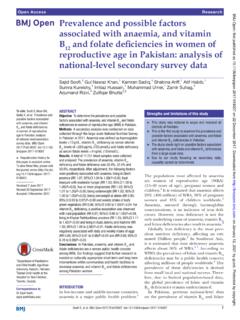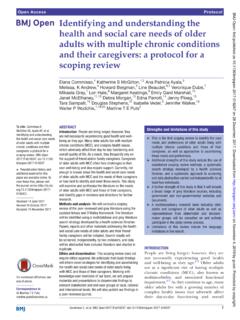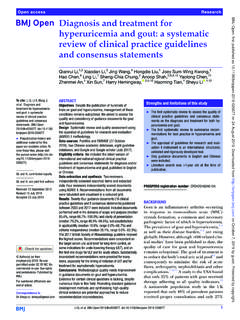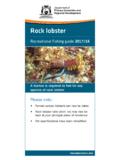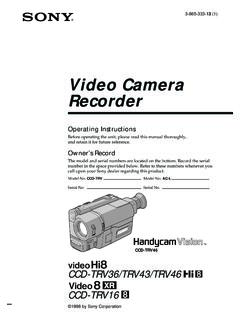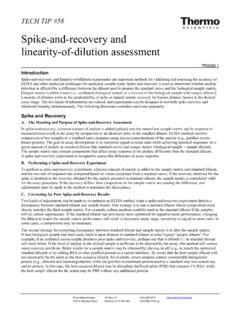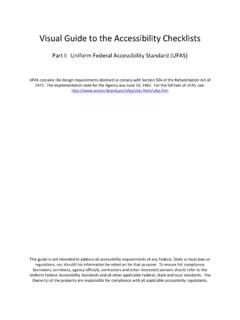Transcription of Open Access Research A systematic review of evidence on ...
1 A systematic review of evidenceon the links between patient experienceand clinical safety and effectivenessCathal Doyle,1 Laura Lennox,1,2 Derek Bell1,2To cite:Doyle C, Lennox L,Bell D. A systematic review ofevidence on the linksbetween patient experienceand clinical safety ;3 Prepublication history andadditional material for thispaper are available online. Toview these files please visitthe journal online( ).Received 18 June 2012 Revised 2 November 2012 Accepted 12 November 2012 This final article is availablefor use under the terms ofthe Creative CommonsAttribution Licence; CLAHRC for NorthWest London, Chelsea andWestminster Hospital,London, UK2 Department of Medicine,Imperial College London,Chelsea and WestminsterHospital, London, UKCorrespondence toDr Cathal explore evidence on the links betweenpatient experience and clinical safety and : systematic :A wide range of settings within primary andsecondary care including hospitals and primary :A wide range of demographic groupsand age and secondary outcome measures:Abroad range of patient safety and clinical effectivenessoutcomes including mortality, physical symptoms,length of stay and adherence to.
2 This study, summarising evidence from55 studies, indicates consistent positive associationsbetween patient experience, patient safety and clinicaleffectiveness for a wide range of disease areas,settings, outcome measures and study designs. Itdemonstrates positive associations between patientexperience and self-rated and objectively measuredhealth outcomes; adherence to recommended clinicalpractice and medication; preventive care (such ashealth-promoting behaviour, use of screening servicesand immunisation); and resource use (such ashospitalisation, length of stay and primary-care visits).There is some evidence of positive associationsbetween patient experience and measures of thetechnical quality of care and adverse events. Overall, itwas more common to find positive associationsbetween patient experience and patient safety andclinical effectiveness than no :The data presented display that patientexperience is positively associated with clinicaleffectiveness and patient safety, and support the casefor the inclusion of patient experience as one of thecentral pillars of quality in healthcare.
3 It supports theargument that the three dimensions of quality shouldbe looked at as a group and not in isolation. Cliniciansshould resist sidelining patient experience as toosubjective or mood-oriented, divorced from the real clinical work of measuring safety and experience is increasingly recognisedas one of the three pillars of quality in health-care alongside clinical effectiveness andpatient the NHS, the measurementof patient experience data to identifystrengths and weaknesses of healthcare deli-very, drive-quality improvement, informARTICLE SUMMARYA rticle focus Should patient experience, as advocated by theInstitute of Medicine and the NHS OutcomesFramework, be seen as one of the pillars ofquality in healthcare alongside patient safety andclinical effectiveness?
4 What aspects of patient experience can be linkedto clinical effectiveness and patient safetyoutcomes? What evidence is available on the links betweenpatient experience and clinical effectiveness andpatient safety outcomes?Key messages The results show that patient experience is con-sistently positively associated with patient safetyand clinical effectiveness across a wide range ofdisease areas, study designs, settings, popula-tion groups and outcome measures. Patient experience is positively associated withself-rated and objectively measured health out-comes; adherence to recommended medicationand treatments; preventative care such as use ofscreening services and immunisations; health-care resource use such as hospitalisation andprimary-care visits; technical quality-of-caredelivery and adverse events.
5 This study supports the argument that patientexperience, clinical effectiveness and patient safetyare linked and should be looked at as a and limitations of this study This study demonstrates an approach to design-ing a systematic review for the catch-all termpatient experience, and brings together evidencefrom a variety of sources that may otherwiseremain dispersed. This was a time-limited review and there isscope to expand this search based on the resultsand broaden the search terms to uncover C, Lennox L, Bell ;3:e001570. AccessResearch on January 7, 2022 by guest. Protected by Open: first published as on 3 January 2013. Downloaded from commissioning and promote patient choice is now 4In addition to data on harm avoidance orsuccess rates for treatments, providers are now assessedon aspects of care such as dignity and respect, compas-sion and involvement in care England,these data are published in Quality Accounts and theCommissioning for Quality and Innovation paymentframework which makes a proportion of care providers income conditional on the improvement in this inclusion of patient experience as a pillar ofquality is often justified on grounds of its intrinsicvalue that the expectation of humane, empathic care isrequires no further justification.
6 It is also justified onmore utilitarian grounds as a means of improvingpatient safety and clinical example,clear information, empathic, two-way communicationand respect for patients beliefs and concerns could leadto patients being more informed and involved indecision-making and create an environment wherepatients are more willing to disclose could have more ownership of clinical deci-sions, entering a therapeutic alliance with could support improved and more timely diagnosis,clinical decisions and advice and lead to fewer unneces-sary referrals or diagnostic patientagency can encourage greater participation in personalcare, compliance with medication, adherence to recom-mended treatment and monitoring of prescriptions can be informed about what to expectfrom treatment and be motivated to report adverseevents or complications and keep a list of their medicalhistories, allergies and current direct experience of care process throughclinical encounters or as an observer (eg, as a patient ona hospital ward) can provide valuable insights into every-day care.
7 Examples include attention to pain control,assistance with bathing or help with feeding, the envir-onment (cleanliness, noise and physical safety) andcoordination of care between professions or organisa-tions. Given the organisational fragmentation of muchof healthcare and the numerous services with whichmany patients interact, the measurement of patientexperience may help provide a whole-system perspec-tive not readily available from more discrete patientsafety and clinical effectiveness on such utilitarian arguments, this studyreviews evidence on links that have been demonstratedbetween patient experience and clinical effectivenessand patient variables relevant to patient experiencePatient experience is a term that encapsulates a numberof dimensions, and in preliminary database searches,this phrase, on its own, uncovered a limited number ofuseful studies.
8 To broaden and structure the search forevidence, identify search terms and provide a frameworkfor analysis, it was necessary to identify what patientexperience entails and outline potential mechanismsthrough which it is proposed to impact on safety andeffectiveness. As such, we combined common elementsfrom patient experience frameworks produced by TheInstitute of Medicine,1 Picker Institute12and 1delineates different dimensions of patientexperience and distinguishes between relational and functional 14 Relational aspects refer to inter-personal aspects of care the ability of clinicians toempathise, respect the preferences of patients, includethem in decision-making and provide information toenable also refers to patients expectationsthat professionals will put their interest above other con-siderations and be honest and transparent when some-thing goes aspects relate to basicexpectations about how care is delivered, such as atten-tion to physical needs, timeliness of care, clean and safeenvironments.
9 Effective coordination between profes-sionals, and these frameworks and discursive documents inthis area of research9101617as a guide, we identifiedTable 1 Identifying aspects of patient experience and search termsRelational aspectsFunctional aspectsEmotional and psychological support, relieving fear and anxiety,treated with respect, kindness, dignity, compassion, understandingEffective treatment delivered by trusted professionalsParticipation of patient in decisions and respect and understandingfor beliefs, values, concerns, preferences and their understandingof their conditionTimely, tailored and expert management of physicalsymptomsInvolvement of, and support for family and carers in decisionsAttention to physical support needs and environmentalneeds (eg, clean, safe, comfortable environment)Clear, comprehensible information and communication tailored topatient needs to support informed decisions (awareness ofavailable options, risks and benefits of treatments) and enableself-careCoordination and continuity of care; smooth transitionsfrom one setting to anotherTransparency, honesty, disclosure when something goes wrong2 Doyle C, Lennox L, Bell ;3:e001570.
10 Between patient experience and clinical safety and effectiveness on January 7, 2022 by guest. Protected by Open: first published as on 3 January 2013. Downloaded from words and phrases commonly used to denote aspects ofpatient experience, examples of which are listed in box were combined with search terms representingpatient safety and clinical effectiveness outcomes,hypothesised to be associated with patient experience indiscursive literature. We searched for a broad range ofoutcome measures, including both self-rated and objec-tive measurements of health status, physical health andmental health and well-being, the use of preventivehealth services, compliance or adherence to health-promoting behaviour and resource these two sets of search terms in theEMBASE database, we identified 5323 papers whoseabstracts were then reviewed.
